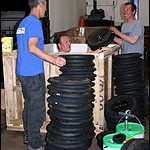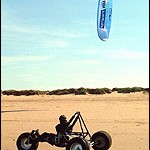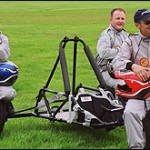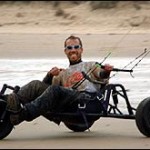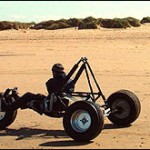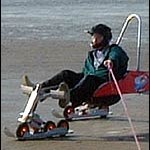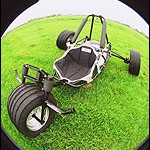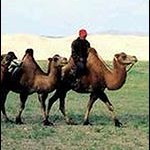Gobi Desert Adventure 2004
Word and photos sourced from https://news.bbc.co.uk/1/hi/england/norfolk/3643359.stm
Three men planning to cross 625 miles of desert using just wind power, are preparing for one of the toughest challenges they’ll ever endure

Preparations are under way for a team of three men to cross the Gobi desert using kite buggies.
Kieron Bradley, 30, and Peter Ash, 34, both from Norfolk, and Professor Brian Cunningham, of Manchester, have sent their equipment for the expedition to Mongolia and are now undergoing their endurance training.
Here, Brian writes about the team’s preparations for the expedition.
Why did you decide to take on this challenge?
Life’s a challenge. You can sit around in your comfort zone for the rest of your life or you can go out and actually live it!
Where did the idea to cross the Gobi desert on kite buggies come from?
When I was doing some buggy tests on a beach I was thinking we need a bigger beach and Kieron suggested we should do it in the desert. The Gobi desert came up in the conversation and it all snowballed from there really.
Can you tell us more about the buggies?
We use the buggies in Norfolk – it’s a very large sport and they’re also used internationally. It’s an up and coming sport.
They’re three wheeled buggies with a kite and use windpower. They’re not as reliable as you’d always like them to be.
I looked at the buggies and thought we could improve them, so I basically adapted them. They’re right at the top end of quality standard wise.
Its not the easiest thing in the world to do. Don’t forget the duration we’ve got to do – it’s a long eight hours in a buggy. I think we’ll have fun – it’ll be rigorous though!
You only have to drop the kite and you’ll rip it to shreds, because it’s not sand that we’ll be on – it’s jagged rocks.
What do you think will be the most challenging aspect of the expedition?
Everyone getting along! We’ve got language barriers with some of the drivers and we have to do this as a team effort. After a couple of weeks it’ll be tiring and you’re going to make mistakes.
I think tempers will be frayed and I think that the heat is also going to be a major thing and yearning to take a drink all the time. We’ve got myself, Brian, two other people, Brian Cunningham and his wife Christine. We’ve also got a driver, a translator and a cook.
How much equipment will you be taking?
It’s really down to the logistics of what we need. We are governed by the support vehicle. We’re looking at 4-5 cubic metres in total.
We won’t take things because we think it would be a fun idea to have on the trip – we’ll only take things that are really necessary.
Is it true that you’ll be passing a dinosaur graveyard on your journey?
Yes that’s true – it should be quite good fun. It’s just as we hit the second leg of the tour. We’re going to stop there for a little while to see what’s going on.
Apparently the fossils are on the surface because of the wind, so it should be quite an eye-opener.
When are you planning to go?
We’re hoping to leave on 28 August. September is the only time we can do it in terms of the weather.
If we go the month before, it’s too hot and after September, it gets so cold it snows. In September it will still be boiling hot, but it will be cold at night. It goes from 40 deg C in the day to -5 deg C at night.
Packing the crates
A few weeks ago, we all went to Pete’s garage for the crate closing ceremony as it’s always a major milestone in an expedition. It was a hectic day but in the end we squeezed everything in.
We packed three Gobi-spec’d Typhoon buggies, plus three spare buggies as back-up and 36 wheels (we’re expecting the rough terrain to be very hard on tyres) all set up with Protex tyre sealant to reduce the risk of punctures.
We also put in 27 kites (a full set of nine kites each ranging in size from 1.8sqm to 11sqm), three tents, sleeping bags, mattresses and the rest of our camping gear along with loads of spares!
Pete and Kieron have done an amazing job in getting the buggies together in time.
As usual there was a host of last-minute things that needed to be done but in the end it all came together and the crate has now started its long journey by sea to China and then overland by rail to Mongolia.
We expect it to arrive in mid-August and be waiting for us when we get there.
Now the three of us have to work on our kiting endurance in preparation for three weeks of eight-hour buggying days.
Endurance training
First, we’ve developed an off-line flying system that transfers the kite load from the pilot to the buggy.
This dramatically reduces the effort required and eliminates the risk of getting lifted out of the buggy by a gust of wind!
We’ve all done extended duration runs of three to four hours using the off-line system without needing a rest, while kite-buggiers using conventional harnesses have been forced to rest every half-hour or so.
In the Gobi we will have a strict policy of always flying the smallest kite that will do the job. This is precisely the opposite of what we normally do on a beach, which is carry the biggest kite we can at all times!
We’d much prefer to travel safely at an average of 10 – 15mph than risk everything by blasting along at 20 – 25mph.
We are all experienced kiters who are well used to long, hard sessions on the beach. Now that the crate is packed all we have to do between now and our departure is to spend as much time in our buggies as we can.
On a long expedition like this, we will build our kiting endurance as we go.
Fit as horses
Last summer my wife Christine and I hiked the John Muir Trail in the California Sierras from Yosemite to Mount Whitney.
It is 220 miles and we crossed a high pass almost every day for three weeks. We had to carry all our food so our packs were huge.
When we started we wondered how we could keep going but by the time we’d been on the trail for a few days we were as fit as horses. The secret is not to push too hard too early.
In the Gobi we will start slow and hopefully finish fast. By the time we are a week into the expedition we will be capable of doing consecutive eight to ten hour days.
Finally, the secret in not getting tired is never to operate at more than about 60% of your maximum capacity. Every burst of 100% is very costly.
I’m an ultra distance runner and this really is the secret. I hope I can pass on my experience to Pete and Kieron!
Rugged terrain
The terrain so far has been challenging with thorny bushes that make Scottish heather seem like a powder-puff and tufts of grassy vegetation that are virtually indestructible.
Dropping the kites in the Gobi desert is not a good idea! From here onwards vegetation should get more sparse and the ground is getting much flatter.
If we get a wind now like we had three days ago, we will fly.
Crossing the Gobi desert is no easy feat, but two men from Norfolk are planning to travel 625 miles of Mongolia’s harsh desert using wind-powered buggies.
Kieron Bradley and Peter Ash who are both from Norwich, came up with the idea after watching a travel documentary on the area of Gobi.
The kite buggies have a top speed of 90mph, but the men will travel at about 30mph.
The expedition will take place in September when temperatures are expected to reach 104 deg F during the day.
Kieron and Peter must wear helmets and body armour in case they are thrown out onto the jagged terrain.
The trip will start in the Altay region of Mongolia and finish in the Erdenaalai region.
They admit it will be hard work but said they aim to have plenty of fun as well. BBC Radio Norfolk’s Chris Goreham spoke to them about their planned adventure.
Lack of wind power
The following day brought almost complete stillness until about 2pm when we had a faint breeze from behind.
Up went the 9sqm kites but almost as soon as we got them set, the wind faded again. We decided to cut our losses and drive a few kilometres to a river for our first wash since leaving the UK.
This morning we awoke again to clear blue skies and no wind and as I write this we are still waiting for the wind to pick up.
It looks like we are in the middle of an anticyclone which has parked itself over the Gobi.
We are ready to set off in the buggies at a moment’s notice and we will remain like this until about 6pm when, if there is no wind, we will have to call it a day.
Three windless days out of four is very unusual. Let’s hope we have a fair wind tomorrow.
First sucessful day of kiting
Our first day kiting was the best day any of us have ever had in a buggy. We covered 50km over difficult ground and gained almost 1000 feet of height.
For most of the day the wind was very strong, perhaps up to 30mph at times. We flew tiny kites, 1.8sqm, 2.0sqm and Kieron flew a 3.5sqm for most of the day.
At times we were in danger of being overpowered. For a couple of hours we were chased by a storm cloud which brought violent gusts of wind.
We ran before the wind at speeds up to 41mph as measured on our GPS (very accurate).
That night we camped when the wind died, very happy indeed to have had such a brilliant start to our expedition.
In this day we had proved the concept was feasible, that the buggies Kieron designed would do the job and that our beautiful PKD kites were superb.
Unfortunately our good wind didn’t reappear in the morning and we spent a frustrating day in the strong sun waiting for a change that never came.
Diary entry: Wednesday 8 September
We arrived in Ulaanbaatar on Tuesday 31 August at 9am after our Aeroflot flight from Heathrow via Moscow.
By 2pm we had unpacked the crates, loaded up the two Russian mini vans, bought a spare charging battery, been to the bank and bought the detailed maps we needed, so off we went.
We camped that night about 50km from Ulaanbaatar.
Two long days later we arrived at our starting point where we spent a day sorting gear and setting up the buggies ready for their journey through the Gobi.
The roads in Mongolia are nothing better than heavily rutted farm tracks. When any particular track gets too worn for comfort, the drivers just avoid the bad bits and create another so-called road.
We saw about one vehicle every hour on this main road to Altai from Ulaanbaatar.
Diary entry: Friday 17 September
We are now making fast progress.
For the first 10 days we were dogged by windless days and progress was patchy.
Every so often we had a spectacular day with big mileage and then we’d be stuck for a day or more waiting for wind. It was hard to establish any momentum.
However, things look as if they might have changed. We have just had our two best days in succession with approximately 70km each day.
This may not sound much but the ground is very much harder than we’d anticipated.
Yesterday, for example, we only had about 1 or 2km across reasonable ground. The rest was through thorn bushes which grow out of sandy mounds up to a half a metre high.
We also had to ascend some big hills. The wind averaged 20mph yesterday and it was right behind us making tricky kiting conditions.
At times we were travelling at 20mph bumping and crashing through these obstacles. The support vehicles could barely keep up with us.
Towards the end of the day Kieron had a spectacular crash into a massive mound and instead of bumping over it his left rear wheel stopped dead.
He spun right round in a 360 degree spin and broke the rear axle clean in two.
The Protex tyre sealant has worked well and we are still on our first set of tyres, although they are peppered with thorns.
Our PKD kites are incredible. We dump them into thorn bushes and still they fly beautifully.
The expedition is now going strongly and today there is already a favourable wind as I write this update at 8am.
Diary entry: Wednesday 22 September
We are now camped within 10km of our destination after a superb day.
Yesterday was hard with difficult wind but today more than made up for it.
We covered just under 82km over the best terrain we’ve seen so far. However, there was a sting in the tail with a difficult traverse of some very rocky hills towards the end of the day.
We could have finished the final 10km today but instead we deliberately stopped here to avoid camping close to the town.
People are so interested in our expedition that we would certainly be mobbed if we continued into Olziyt.
We will finish the final 10km tomorrow.
It is hard for us to realise that we have now completed the first kite-powered crossing of the Gobi Desert.
All our gear and our support team have been great.
The PKD Century kites have been brilliant in the most demanding of conditions. We have not had a single kite failure despite some desperate weather and horrible terrain.
The buggies have taken dreadful punishment and are still going strong.
We are hugely grateful to all our sponsors for their enthusiastic support and for having the faith in us to complete this adventure
Word and photos sourced from https://news.bbc.co.uk/1/hi/england/norfolk/3643359.stm
If you fancy having a buggying trip in the Gobi Dessert look HERE

